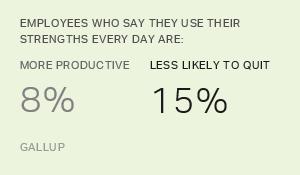Gallup's latest State of the Global Workplace report analyzes how businesses around the world are evolving to make better use of the human capital available to them.
The evolution is in response to the way people work best. Many organizations are moving away from hierarchical, function-based structures in favor of team-based arrangements that are more flexible and goal-oriented.
As organizations reorganize for speed and agility to stay competitive, authority is becoming less centralized than in the past. Teams constantly form, disband and reform according to the needs of specific projects and customers.
Information and communication technologies have helped make it possible to stay coordinated as people become more mobile and their job descriptions are less permanent.
But these changes also place different demands on employees. Employers need them to be more adaptable and self-directed, better able to identify teams and projects that would allow them to excel and maximize their value to the company.
In turn, employees need a higher level of self-awareness to navigate their careers amid organizational environments that are more fluid than ever before.
Gallup's research proves that if there is one area of focus with the potential to transform entire organizational cultures to help meet these needs -- and deliver improved business outcomes, too -- it is a strengths-based approach to management.
CliftonStrengths Development Helps Ground Individuals and Teams Amid Rapid Change
Gallup's late Chairman Don Clifton pioneered the study of strengths in the workplace, affirming through decades of research that employees who use their strengths on the job are more likely than others to be intrinsically motivated by their work, simply because it feels less like work to them.
Among a host of benefits individuals experience when they know and use their CliftonStrengths, employees who say they use their strengths every day are 8% more productive and 15% less likely to quit their jobs. They are also more likely to strongly agree that they like what they do each day.
Importantly, Clifton defined talent as the naturally recurring patterns of thought, feeling or behavior that can be productively applied. The natural talents we all have can be turned into strengths through investing in their development -- time spent practicing and developing skills.
Focusing on innate talent as a foundation has become increasingly important as the pace of technological change has quickened, because in many industries specific skills and knowledge have a shorter lifespan than they once did.
Employees need continual learning and development opportunities in order to stay up to date. Understanding their strengths gives them a basis for choosing the developmental paths that are most likely to help them sustain a long, successful career.
From the standpoint of individual employees, then, a strengths foundation that includes coaching and development provides a sense of their "true north" -- helping them stay oriented for high productivity amid shifting workplace needs and varying career trajectories. But as more businesses restructure their processes around team-based work, the benefits of a strengths-based culture for group interactions also becomes more important.
Team members who know each other's strengths more effectively relate to one another, avoiding potential conflicts and boosting group cohesion. Strengths-based development immediately changes their conversations. It creates more positive dialogue, and it boosts the team's overall engagement and performance.
Tools like Gallup's CliftonStrengths assessment give team members a common language for understanding and trusting in one another's capabilities, helping to establish a positive dynamic from the outset when a new team is assembled.
Gallup analysts recently conducted a study of 11,441 teams in six organizations where at least 30% of employees had completed the CliftonStrengths assessment. They determined that team members' awareness of their own strengths -- and each other's -- was more strongly related to higher engagement and performance than was the specific composition of strengths on the team.
Managers Are Critical to Successfully Creating a Strengths-Based Culture
The manager's role changes substantially in a strengths-based culture. Namely, they're the key conduit to implementing a genuine strengths-based development approach and maximizing the potential of their workplace's talent.
Managers become more like coaches, dedicated to helping team members understand and cultivate their talents, thereby achieving high levels of productivity and fulfillment. This change aligns with research by Gallup and others showing that younger workers -- particularly millennials -- want and expect their managers to work with them on personal and professional development opportunities.
As the organizations of the future evolve in response to ongoing digitization and the global redistribution of work, the trend toward looser, more adaptable networks of employees is likely to continue. Further, with the rise of the gig economy, businesses are increasingly sourcing external talent so that teams increasingly include freelance or independent workers who may be even more loosely affiliated with others on the team.
As organizations figure out how best to implement these changes, they need new ways to help teams retain cohesion, and to ensure that the right talent is able to flow to projects that will make the best use of their skills. As Gallup research has demonstrated time and again, organizations that adopt a strengths-based culture will have a powerful advantage on both fronts.
Take an in-depth look at Gallup's global workforce research, including ways you can bring the power of a strengths-based culture to your organization:
-
Watch the on-demand webinar "7 Ways to Build a Strengths-Based Culture."
-
Learn why and how the best organizations use CliftonStrengths to succeed.


